Blockchain-Based Radioactive and Hazardous Material Management System
- Home
- Success stories
Hyperledger Fabric-based system for monitoring, analyzing, and managing the entire radioactive materials supply chain, including all movements and operations performed and the history of transfers between organizations.
Team
- UI/UX designer2
- Business analyst1
- Project manager1
- DevOps
- Developers4
- QA engineer2
Project goals
Build a blockchain ecosystem with a web and mobile interface that would enable the processes of radioactive materials storage, transport, and disposal to be carried out transparently. The platform needed to provide efficient data management with access roles tied to administrators and storage facility personnel who handle the transport of hazardous materials and associated operations.
Work done
- 1Administrator web portal for enforcing policies and regulations, managing storage, and transporting radioactive materials.
- 2Full integration with existing ERP systems and SAP modules, including warehouse management, trip and delivery, transportation, automation planning, administration, etc.
- 3Mobile application for storage facility personnel to take radioactive materials into custody and manage their proper handling.
Solution
Technologies used:
Typical use cases
Materials management
The platform can be used by hospitals, research facilities, and manufacturing sites to document and track the maintenance of hazardous materials, and monitor equipment and storage facility conditions.Overseeing of materials handling
Using the platform, government authorities and companies that deal with these materials can oversee radioactive material handling. Government authorities can also audit and verify these processes and issue licenses to the organizations.

Radiation management
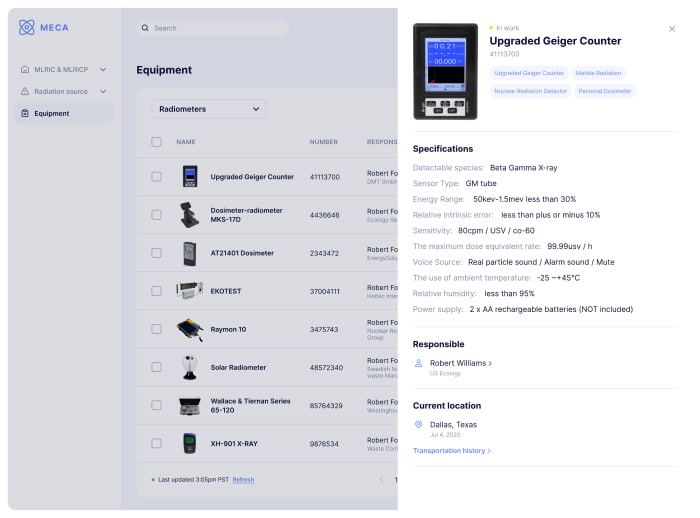
Equipment management
- Container tracking
- Inventory management
- Treatment and conditioning
- Authorization and approval
- Generating inventory reports
- Storage and disposal
- Waste management
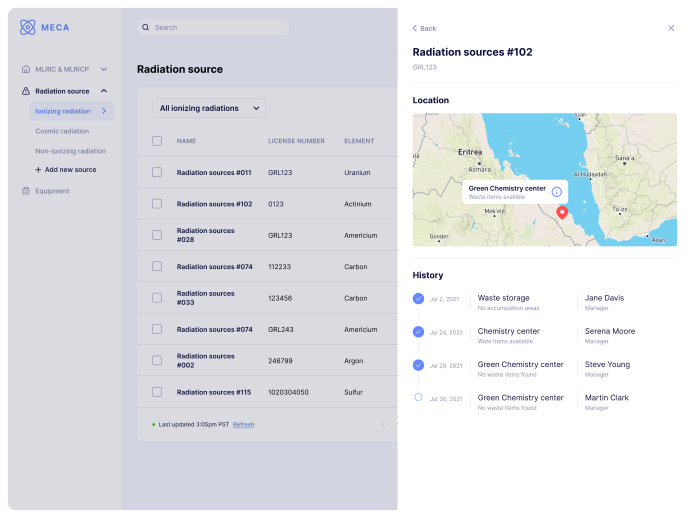
Radiation source tracking
- Shipping and transportation
- Receiving areas
- Warehouses and storage facilities
- Manufacturing and processing lines
- Lobbies and security posts
- Laboratories
- Disposal facilities.
Security management
In order to ensure safe and secure handling, and to avoid the risks of injury and damage to property as a result of mishandling, the system offers convenient digital material safety data sheets (MSDS) management.
- Each data sheet is tied to the specific hazardous material
- The data sheets contain information on material properties, its composition, physical health, environmental hazards, protective measures, and safety precautions for handling and transporting the material
- The data sheets can be accessed from the handler’s mobile device by scanning the QR code of the container, thus enabling the personnel at each location of the supply chain or within a storage facility to know the exact safety procedures
The platform also allows generating compliance reports that can be directly accessed and verified by regulatory authorities.
Security management
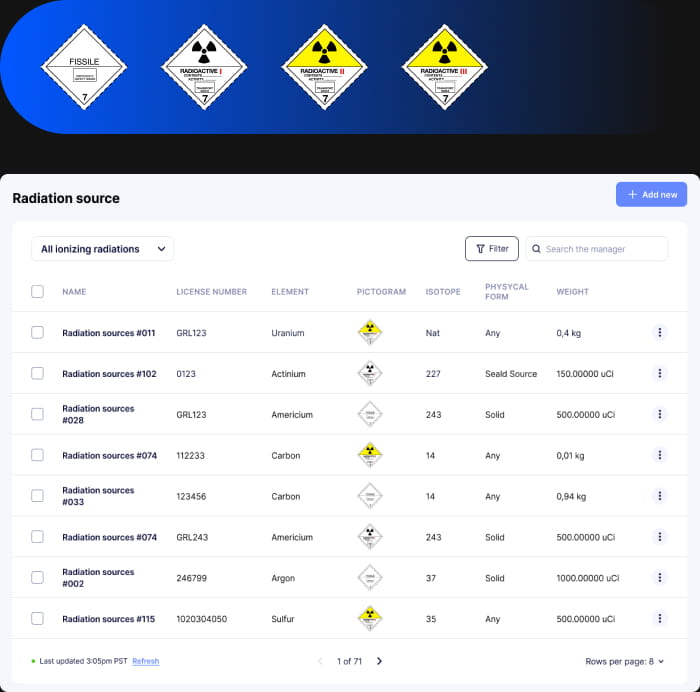
Radiation asset management
The solution offers the admin web portal, which is used by the representatives of the regulative authority for creating new records of radiation sources and materials. The system also allows them to specify the material’s parameters and details, such as the radiation level.
- 1
Record creation
A record is created and added to the blockchain and timestamped according to the date of its creation.
- 2
Materials movement tracking
The timestamp can be later used to track the movement of certain materials and view their maintenance history all the way back to their origins.
- 3
QR code assignment
A QR code is also assigned to the new radiation source and used by storage facility personnel for acceptance.
- 4
Records tracking
Organizations view the created records of radioactive materials assigned to them, as well as the history of transfers of these materials from the place they are utilized to the disposal facilities.
Blockchain implementation benefits
Since all the information is recorded on the blockchain and distributed across the whole supply chain landscape, there’s no more trouble with different parts of the system being isolated and no need for complex integrations of distributed databases and legacy applications.
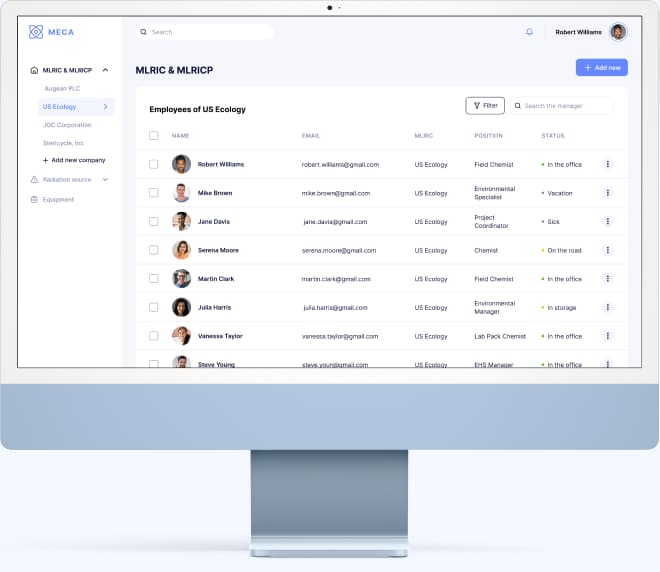
- Using Hyperledger as a platform for hazardous material management brings the following advantages for companies and regulatory authorities:
- Easy access to all the information required for managing hazardous materials, with extensive capabilities for searching and filtering
- Everyone works within a single environment, so regulatory experts are able to directly enforce requirements and companies have an easier way to maintain compliance
- By eliminating redundant processes and streamlining information exchange, the system enables hazardous material storage to be more secure and significantly reduces operational expenses
- Another major benefit of a platform based on blockchain is the use of smart contracts to eliminate third-party certification and verification processes. All of the terms and requirements are programmed into the smart contract, and it automatically executes after its conditions have been met. It results in the following benefits:
- It speeds up compliance and exchange processes considerably
- It also builds more trust, since agreements are executed through an unbiased digital process
Radioactive material handling and disposal with mobile app
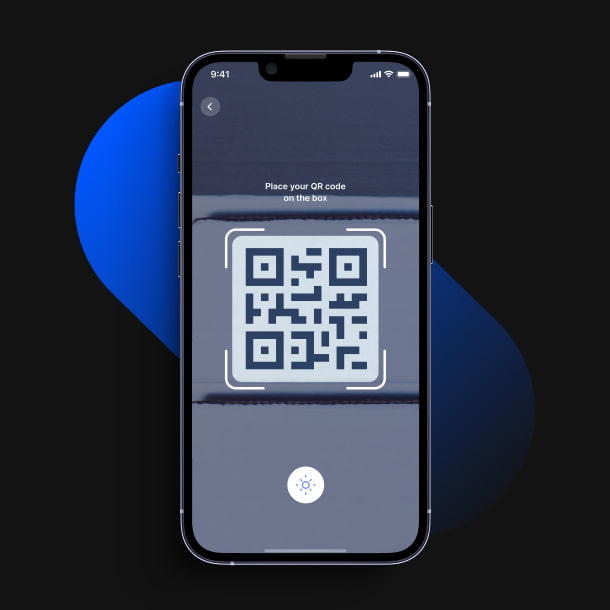
QR codes to scan radioactive materials
Storage facility personnel have the ability to scan QR codes of radioactive materials and take them under their custody. They can also view all the materials, record maintenance details and other parameters, and monitor storage conditions.

360-degree view of materials handling
This information is recorded on the blockchain and distributed across all users with the proper access rights. Thus, all of the parties involved have a bird’s-eye view over radioactive material handling and disposal.
Project features
- Hyperledger Fabric blockchain storage to provide universal access for all stakeholders
- Radiation source management
- Radiation equipment management
- Full history of radiation source movements and handling
- QR codes generated to identify radiation materials
- Services IT R&D RESEARCH & DEVELOPMENT In this ever-evolving tech realm, don't just follow trends — set them.Capitalize on innovation, launch ground-breaking products, and forge new business models for maximum ROI. IT Consulting CONSULTING From complex enterprise tech transformation to the innovative project launch, our team supports businesses at different stages of their projects.Come along, we’ll help you get an edge and play big on the global market. Custom Software Development CUSTOM ENGINEERING Let us have your back in a project of any scale. From user-centric mobile apps to full-blown cross-platform enterprise ecosystems — we’ll bring your concept to life, exactly as you think it should look and work. Mobile App Development MOBILE APP DEVELOPMENT Entrust us with your end-to-end mobile project — from ideation and engineering to app launch and integration.With business growth in mind, we’ll help you hit the market with a slick iOS, Android, or cross-platform app. Mobile App Development iOS App Development Android App Development Cross-Platform App DevelopmentWeb Development WEB DEVELOPMENT Whether you need an app from the ground up or require a legacy system to be updated, we can jump in at any stage.From an accessibility roadmap to post-launch support, we’ll help your business stay strictly legal and competitive. Web Development Web Accessibility Audit Web Accessibility Consulting Accessible Web Development and DesignDevSecOps DevSecOps Ensure your software's integrity and efficiency from conception to compliance. UI/UX Design UI/UX DESIGN Give us the pleasure of adding our secret sauce to your app.We’ll create beautiful screens at the front while breaking the limits of what’s behind them to help your app get to beyond-plausible business achievements. QA & Software Testing QA & SOFTWARE TESTING Engage us for integrated quality assurance services, and our experts will advise on QA strategy and optimize software testing costs.We’ll balance manual testing with QA automation to ensure consistent performance for all possible use cases and devices.
- Technologies Blockchain BLOCKCHAIN DEVELOPMENT Blockchain Development Blockchain Consulting NFT Development STO Development ZK Rollup Solutions Enterprise Blockchain Development Smart Contracts Development Smart Contract Audit DApp Development Cryptocurrency Exchange DevelopmentData Science DATA SCIENCE Transforming data into growth strategies is our specialty.Leverage our expertise to unlock the potential of your big data and diverse digital assets, driving business growth. Big Data Consulting Data Analytics Business Intelligence Data VisualizationMachine Learning and AI ARTIFICIAL INTELLIGENCE Machine Learning Predictive Analytics Computer Vision Custom AI Development Chatbot DevelopmentAR & VR AUGMENTED VIRTUAL REALITY Immerse your customers into a universe of unimaginable and give them truly novel experiences with AR, VR, and Mixed Reality.We'll help define a proper business concept and find a balance between legacy workflows and next-gen customer engagement solutions. Metaverse METAVERSE We create tools, assets, and ecosystems to seamlessly merge real-life and digital worlds within your Metaverse projects.It could be a multi-layer virtual space or a unique artwork item. Either way, we’ll deliver it — ready and working. Connected Devices (IoT) INTERNET-OF-THINGS Aching to handle digital and physical asset management? We build load-resistant IoT services, both enterprise and consumer.Hit us with IoT consulting, app development, back-end engineering, or existing infrastructure revamping – we’ll nail it down.
- Industries FinTech & Banking FINTECH & BANKING As traditional finance goes digital, we are committed to building efficient ecosystems and better engagementThink of customized FinTech solutions with tamper-proof transactions and storage, progress transparency and automation — and we’ll make them see the light of day. Retail & eCommerce RETAIL & ECOMMERCE Whether you market B2B or B2C, commerce tech trends are all about value-driven purposes, global sustainability, hybrid shopping journeys, and extra-resiliency.Let your clients know that there’s more to your brand than meets the eye by creating unique customer experiences in all your stores. Supply Chain & Logistics SUPPLY CHAIN & LOGISTICS To make things easier for all vendors, we deliver apps for route and cost optimization, vehicle operational support, and better dispatch time efficiency.With focus is sustainability, resilience, transparency, and immutability, let’s get your transformation going. Healthcare HEALTHCARE Custom healthcare software solutions are aimed at helping you ensure accurate diagnosis, better patient engagement, and positive healthcare outcomes.Whether you require a patient management solution, practice management software, EMR/EHR system, or ML-enabled diagnostics – we’ve got you covered. Real Estate REAL ESTATE Keep up with digital innovation trends by accelerating enterprise transformation and scaling, leveraging data and orchestrating workflows.Whether you manage and sell commercial facilities or invest third-party capital, our integrated solutions help you make the most of it. Oil & Gas OIL & GAS With mobility and digital technologies standing to change the game and define leadership, our mission is to get you digital-first.Resolve operational and conceptual issues by introducing clear tech vision, feasible architectures, and flexible software to take business extension off limits.
- Solutions Know-Your-Transaction KYT platform ensures financial integrity, compliance, and proactive risk management. Control your operations seamlessly with real-time API integration. DocFlow Secure workflows, decentralized storage, and total document control. Streamline your processes with our business document management system. Arbitrage Bot Alternate your yield channels, maximize investment efficiency, customize trading strategies, and execute profitable low-risk transactions. CryptoAPI Connect your dApps to blockchains commission-free. No need for heavy database upload, infrastructure updates, or a dedicated engineering team. OTC Hawk Redefine wealth and portfolio management at your firm, outpacing your competitors. Make crypto/fiat trading easy and profitable for your clients.
- Success stories Blockchain Government & Enterprise Energy & Utilities Financial Services Supply Chain Healthcare Retail & eCommerce See all projects
- Company About us Team News Careers Scholarship CSR Contacts
- Blog